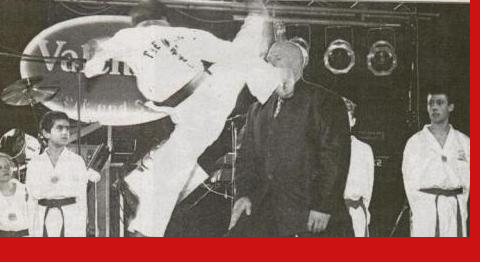 | | 
 |
|
Tenets of Taekwondo
Tenets of Taekwondo
• Courtesy (Ye Ui)
• Integrity(Yom Chi)
• Perseverance(In Nae)
• Self Control(Guk Gi)
• Indomitable Spirit(Beakjul Boolgool)
Student Oath
I shall observe the Tenets of Taekwondo.
I shall respect Instructors and Seniors.
I shall never misuse Taekwondo.
I will be a champion of freedom and justice.
I will build a more peaceful world.
3 Major Areas of Tae Kwon Do Practice
1.Poomse(Patterans) 2.Girugi (Sparing) 3.Kyek Pa(Breaking)
1.Patterns
Patterns are prearranged sequences of attack and defence moves against imaginary opponents. They are designed to improve power, accuracy and speed and to make techniques reflex actions rather than the result of (Slow) conscious thought. The names of the patterns for the coloured belt grade (kup) students is from the TAE GEUK (Tal Chi, in Chinese), the ultimate principle in oriental philosophy. TAE means “great” and GEUK means “ultimate” or “eternal”. Each pattern represents one of the Eight Trigrams (Pal Gwe) of the I Chin- (The book of Changes).
2. Girugi(Sparring)
Sparring is the practical application of various forms against an actual opponent. In this type of competition cooperation, self-control, concentration, respect for yourself and your partner, speed, skilled technique, precision, and confidence are the deciding factors. (you will learn safely through a step-by-step systematic method of gradually learned sparring strategies – this is easy to learn and is a lot of fun)
3.Breaking
Breaking is done to practice and illustrate the formidable power, precision, and great mental concentration of the Tae Kwon Do practitioner. Bricks, rocks, boards, cement blocks, and such are broken since it is not feasible to use this sort of power on another person in everyday practice!
The philosophy of Taekwondo
1. See Rightly
A student learns what Taekwondo is as an artform and way of life. A proper perspective is necessary to view all things in a just manner.
2. Feel Rightly
Emotional control is necessary to act justly. Avoiding extremes in emotions helps students to live balanced lives. Logic, values, and reasoning should control the actions of the martial artist, not moments of anger, frustration or the like.
3. Think Rightly
Moral values are developed in Taekwondo practice. Taekwondo practitioners learn to know the difference between right and wrong, striving always to act in accordance with learned principles.
4. Speak Rightly
Integrity is the foundation of all good communication. Without it, reality is not known to us, no matter if we speak the falsehoods, or if they are spoken to us. Truthfulness alone can prevent other abberations of character, which can lead to greed, theft, disloyalty and arrogance. Always act with integrity!
5. Command Rightly
Teachers and others in authority have en enormous responsibility to request only that which is right of those under their leadership. Worthy Taekwondo martial artists always consider this tenet when dealing with others under their command.
6. Serve Rightly
Be a good citizen and do what is right. Give to the good of the community in whatever ways you are able. Be loyal and true in all your endeavors.
7. Have Ability
Train hard and persevere. Achieve mastery of your art to the best of your ability.
8. Conduct with Justice
Act fairly and respectfully at all times. Strive to set forth a good example for others to follow.
Taekwondo Terminology--------------------------
| Tae |
kick or smash
with feet |
| Kwon |
fist/punch |
| Do |
art/way |
| Charyot |
Attention |
| Kyong-ye |
Bow |
| Joonbi |
Ready
(adopt the appropriate ready stance) |
| Seejak (Sisak) |
Begin |
| Geuman |
Stop |
| Baro |
Return
(to previous position, often joonbi stance) |
| Kyek pa |
Breaking |
| Hosnisul |
Self
defence |
| Do Rah |
Turn
Around |
| Kyorugi |
Sparring |
| Dojang |
Training
hall |
| Dobok |
Uniform |
| Kihap |
Yell |
| T (Te) |
Belt |
| Chung |
Blue |
| Hong |
Red |
| Kal yeo |
Break |
| Kye sok |
Continue |
| Sogi |
Stance |
| Ap Sogi |
Short
walking stance |
| Ap Kubi |
Long
walking stance |
| Char-ryut |
Attention
stance |
| Choonbi |
Ready
stance |
| Bom Sogi |
Tiger
stance |
| Juchum Sogi |
Sitting
stance |
| Pyong Sogi |
Parallel
stance |
| Dwit kubi |
Back
stance |
| Ap chagi |
Front
kick |
| Ap cha-olligi |
Front
raising kick |
| Dolryo chagi |
Front
Turning kick |
| Yeop chagi |
Side
kick |
| Bituro chagi |
Twisting
kick |
| Bandae dollyo chagi |
Reverse
turning kick |
| Bandal chagi |
Crescent
kick |
| Twimyo chagi |
Jumping
kick |
| Baro chirugi |
Obverse
punch |
| Bandae chirugi |
Reverse
punch |
| Du chirugi |
Double
punch |
| Yeop chirugi |
Side
punch |
| Dung jumuk |
Back
fist |
| Sonkut |
Spear
hand |
| Son-nal |
Knife
hand |
| Son-nal dung |
Ridge
hand |
| Makki |
Block |
| Arae makki |
Low
section block |
| Momtong makki |
Middle
section block |
| An makki |
inward
block |
| Olgul makki |
Upward
rising block |
| Son-nal makki |
Knife
hand block |
| San makki |
W
shape block |
| Palmok daebi makki |
Forearm
guarding block |
| Hecho yo makki |
Wedging
block |
| An palmok makki |
Inside
forearm block |
| Pakat palmok makki |
Outside
forearm block |
| Number | Command | Naming |
|---|
| 1 | Hana | Il
| | 2 | Dul | Ee | | 3 | Seyt | Sam | | 4 | Neyt | Sa | | 5 | Dosut | O | | 6 | Yosut | yuk | | 7 | Ilgop | Chil | | 8 | Yudol | Pal | | 9 | Ahop | Ku | | 10 | Yul | Sip |
Colour
Belt Patterns
SAJU CHIREUGI
Four-directional punching; for 9th kup
TAE GEUK IL JANG
Represents HEAVEN and LIGHT:for 8th kup; perform clearly and methodologically,
but fluently
TAE GEUK EE JANG
Represents JOYFULLNESS :for 7th kup; perform gently but forcefully
TAE GEUK SAM JANG
Represents FIRE and SUN :for 6th kup; perform with vitality and passion
TAE GEUK SA JANG
Represents THUNDER :for 5th kup; perform with strength and power
TAE GEUK O JANG
Represents WIND :for 4th kup; perform alternately as slow/graceful and
strong/fast
TAE GEUK YUK JANG
Represents WATER :for 3rd kup
TAE GEUK CHIL JANG
Represents MOUNTAIN for 2nd kup; perform with stability
TAE GEUK PAL JANG
Represents EARTH :for 1st kup; perform with strength and unbending force
 |
|
|
 |








